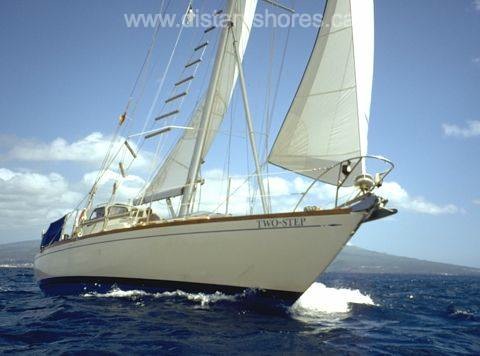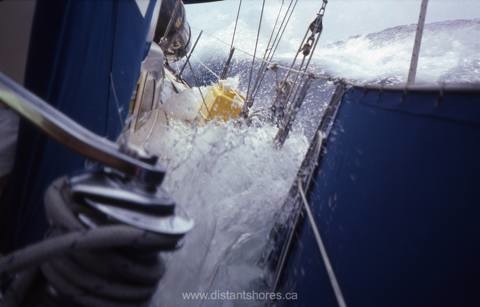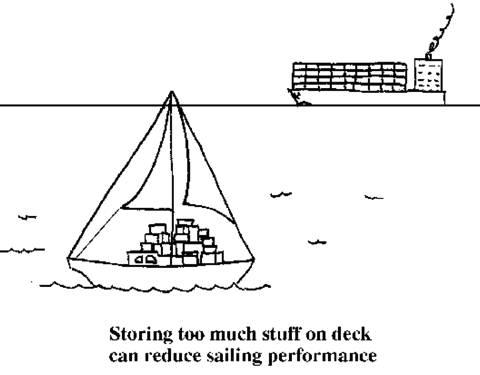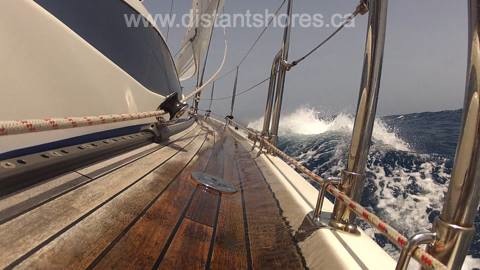Clear the Decks
06/11/14 08:37 Filed in: Offshore sailing
25 years ago when Sheryl and I were building and outfitting our first boat, Two-Step, we tried to imagine sailing her in a storm. As a result, we designed the deck layout so we could handle most tasks from the cockpit and bought heavy weather sails.

It is interesting to look back on our trip and see just how much heavy weather we encountered. In three years --1050 days of living aboard during an Atlantic circle trip -- we were under way for a total of 4500 hours or nearly 200 days full time. Of that time, 120 days were spent out of sight of land on passages ranging from 2 to 20 days in length and only 9 days were spent in heavy weather! Less than 1 percent of the cruise (8% of the time offshore) was spent in the storm conditions we had thought so much about.

In retrospect, it might seem strange to have put so much effort and expense into arrangements to benefit us for such a rare occurrence. But the time was certainly not misspent!
The heavy sails and rigging helped Two-Step to avoid problems -- a form of insurance that paid out, without an accident happening.
And by planning the deck layout for easy single-handing, we simplified the sailing at all times.
One of the most common “on deck” problems we have seen on cruising boats is too much clutter. We fell into this trap when we left Florida on our first blue water passage to Bermuda. We bought extra jerry jugs for fuel, water and gasoline, and even an extra propane can (besides the two in the vented propane locker). We set sail with nine 5-gallon jugs, the extra propane can and some teak boards (never know when you might need them), lashed on deck. This was more than 300 pounds of weight well above our centre of gravity! Two-Step wallowed off into the Gulf Stream, taking noticeably longer to recover when the seas slapped her.

In a moderate blow 2 days later, a boarding wave tore the lashings and swept the gasoline jug and the propane can over the side. I prefer to think that I was being told to keep the deck clear. Since then we have eliminated all but two of the Jerry cans -- they each contain 5 gallons of water to be grabbed in case we ever have to abandon ship.
Nowadays on board Distant Shores II we keep the decks completely clear. Everything including fenders and jerry cans are stowed before we get underway. Sometimes I think people don't recognize us as a cruising boat because we are not cluttered enough! (Although the discerning eye will notice the wifi booster and the 20 foot high SSB antenna on the stern). Our boat performs just as well as she did when we bought her. She has no additional weight up on deck and sails better because of it.

If you have plans to lash jugs on deck it might be good to check with a designer and make sure the stanchions can handle the additional force. They were designed to save people from going overboard, not to have a 2X6 board and hundreds of pounds of stuff lashed on to them. Our mistake when we went offshore overloaded on Two-Step was that we didn't really need all that stuff. We couldn't possibly need the extra propane on a passage, nor the additional fuel or water. She was a small 37-footer by modern standards but she did have enough capacity in tanks to cross oceans when set up properly.
Setting up a boat “on-deck” for long-term and ocean cruising is really an exercise in common sense. If you plan to sail short-handed, as we and most cruisers do, organizing the deck for single-handing will allow the off-watch crew to get an undisturbed rest on passages. If you plan offshore passages it is important to consider heavy weather. Preparation is the best insurance you can get.
Here is a scene from Distant Shores Season 9 with stormy sailing conditions on the ARC Transatlantic Crossing.
blog comments powered by Disqus